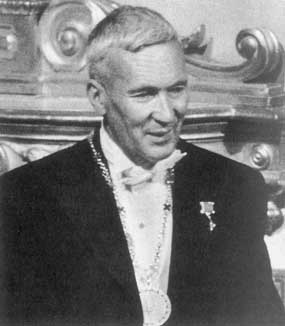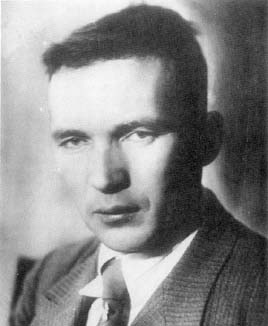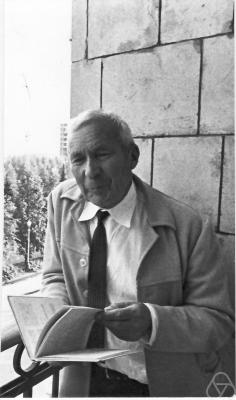<Back to Index>
- Mathematician
Andrey Nikolaevich
Kolmogorov, 1903
PAGE SPONSOR



Andrey Nikolaevich Kolmogorov (Russian: Андре́й Никола́евич Колмого́ров) (25 April 1903 – 20 October 1987) was a Soviet mathematician, preeminent in the 20th century, who advanced various scientific fields, among them probability theory, topology, intuitionistic logic, turbulence, classical mechanics and computational complexity.
Kolmogorov was born in Tambov, about 500 kilometers south - southeast of Moscow, in 1903. His mother named Kolmogorova, who was not married, died in childbirth and he was raised by two of his aunts in Tunoshna near Yaroslavl at the estate of his grandfather, a well-to-do nobleman.
Little is known about his father, not even his name, except that he was an agronomist who was deported from St. Petersburg for participation in the revolutionary movement against the czars. He disappeared and he was presumed to have been killed in the Russian Civil War.
Kolmogorov was educated in his aunt's village school, and his earliest literary efforts and mathematical papers were printed in the school newspaper. As a teenager, he designed "perpetual motion machines", concealing their (necessary) defects so cleverly that his secondary school teachers could not discover them. In 1910, his aunt adopted him and then they moved to Moscow, where he went to high school, graduating from it in 1920.
In 1920, Kolmogorov began to study at the Moscow State University and the Chemistry Technological Institute.
Kolmogorov gained a reputation for his wide ranging erudition. As an undergraduate student in college, he attended the seminars of the Russian historian S.V. Bachrushin, and he published his first research paper on the landholding practices in the Novgorod Republic during the fifteenth and sixteenth centuries. During the same period (1921 - 22), Kolmogorov worked out and proved several results in set theory and in the theory of Fourier series (trigonometric series).
In 1922 Kolmogorov constructed a Fourier series that diverges almost everywhere, gaining international recognition. Around this time he decided to devote his life to mathematics. In 1925, Kolmogorov graduated from the Moscow State University, and he began to study under the supervision of Nikolai Luzin. He made lifelong friends with Pavel Alexandrov. Both were involved in 1936 in political persecution of their common teacher Nikolai Luzin, the so-called Luzin affair. According to some researchers, Kolmogorov and Alexandrov were involved in a homosexual relationship, while others deny this and suppose that this rumor was spread in the 1950s in order to rehabilitate the participants of the Luzin affair. Kolmogorov (together with Aleksandr Khinchin) became interested in probability theory. Also in 1925, he published his famous work in intuitionistic logic - On the principle of the excluded middle, in which he proved that under a certain interpretation, all statements of classical formal logic can be formulated as those of intuitionistic logic. In 1929, Kolmogorov earned his Doctor of Philosophy (Ph.D.) degree, from the Moscow State University.
In 1930, Kolmogorov went on his first long trip abroad, traveling to Göttingen and Munich, Germany, and then to Paris, France. His pioneering work About the Analytical Methods of Probability Theory was published (in German) in 1931. Also in 1931, he became a professor at the Moscow State University.
In 1933, Kolmogorov published his book, the Foundations of the Theory of Probability, laying the modern axiomatic foundations of probability theory and establishing his reputation as the world's leading expert in this field. In 1935, Kolmogorov became the first chairman of the department of probability theory at the Moscow State University. In 1939, he was elected a full member (academician) of the USSR Academy of Sciences. In a 1938 paper, Kolmogorov "established the basic theorems for smoothing and predicting stationary stochastic processes" - a paper that would have major military applications during the Cold War. Around the same years (1936) Kolmogorov contributed to the field of ecology and generalized the Lotka – Volterra model of predator - prey systems.
In his study of stochastic processes (random processes), especially Markov processes, Kolmogorov and the British mathematician Sydney Chapman independently developed the pivotal set of equations in the field, which have been given the name of the Chapman – Kolmogorov equations.
Later on, Kolmogorov changed his research interests to the area of turbulence, where his publications beginning in 1941 had a significant influence on the field. In classical mechanics, he is best known for the Kolmogorov – Arnold – Moser theorem (first presented in 1954 at the International Congress of Mathematicians). In 1957, he solved a particular interpretation of Hilbert's thirteenth problem (a joint work with his student V. I. Arnold). He was a founder of algorithmic complexity theory, often referred to as Kolmogorov complexity theory, which he began to develop around this time.
Kolmogorov married Anna Dmitrievna Egorova in 1942. He pursued a vigorous teaching routine throughout his life, not only at the university level but also with younger children, as he was actively involved in developing a pedagogy for gifted children, in literature, and in music, as well as in mathematics. At the Moscow State University, Kolmogorov occupied different positions, including the heads of several departments: probability, statistics, and random processes; mathematical logic; and he also served as the Dean of the Moscow State University Department of Mechanics and Mathematics.
In 1971, Kolmogorov joined an oceanographic expedition aboard the research vessel Dmitri Mendeleev. He wrote a number of articles for the Great Soviet Encyclopedia. In his later years he devoted much of his effort to the mathematical and philosophical relationships with probability theory arising in abstract and applied areas.
Kolmogorov died in Moscow in 1987, and his remains were buried in the Novodevichy cemetery.
A quotation attributed to Kolmogorov is [translated into English]: "Every mathematician believes that he is ahead over all others. The reason why they don't say this in public, is because they are intelligent people."